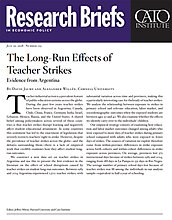We construct a new data set on teacher strikes in Argentina and use this to present the first evidence in the literature on the effect of school disruptions caused by teacher strikes on student long-run outcomes. Between 1983 and 2014 Argentina experienced 1,500 teacher strikes, with substantial variation across time and provinces, making this a particularly interesting case for the study of teacher strikes. We analyze the relationship between exposure to strikes in primary school and relevant education, labor market, and sociodemographic outcomes when the exposed students are between ages 30 and 40. We also examine whether the effects we identify carry over to the individuals’ children.
Our empirical strategy consists of examining how education and labor market outcomes changed among adults who were exposed to more days of teacher strikes during primary school compared with adults who were exposed to fewer days of strikes. The sources of variation we exploit therefore come from within-province differences in strike exposure across birth cohorts and within-cohort differences in strike exposure across provinces. On average, provinces lost 372 instructional days because of strikes between 1983 and 2014, ranging from 188 days in La Pampa to 531 days in Rio Negro. The average number of primary school days lost because of teacher strikes was 88 among the individuals in our analysis sample—equivalent to half a year of schooling.
The main assumptions underlying our estimation strategy are that there are no shocks (or other policies) contemporaneous with teacher strikes that differentially affect the various cohorts and that the timing of teacher strikes is uncorrelated with prior trends in outcomes across birth cohorts within each province. We show extensive evidence that our data are consistent with these assumptions. In particular, our results are robust to controlling for local labor market conditions, accounting for cross-province mobility, excluding regions with persistently high frequencies of teacher strikes, and controlling for province-specific nonteacher strikes. We also show that the effects we identify disappear when reassigning treatment to cohorts that have just graduated from—or have not yet started—primary school, indicating that the timing of teacher strikes is uncorrelated with trends in outcomes across birth cohorts within each province.
We find robust evidence in support of adverse labor market effects when the students are between ages 30 and 40: being exposed to the average incidence of teacher strikes during primary school reduces wages for males and females by 3.2 percent and 1.9 percent, respectively. We find some suggestive evidence that exposure to strikes in early grades has larger effects than exposure in later grades, although these differences are often not statistically significantly different from zero. The prevalence of teacher strikes in Argentina means that the effect on the economy as a whole is substantial: a back-of-the-envelope calculation suggests an aggregate annual earnings loss of $2.34 billion. This amount is equivalent to the cost of raising the average employment income of all primary school teachers in Argentina by 62.4 percent.
In addition to adverse wage and earnings effects, our results reveal negative effects on several other labor market outcomes. With respect to males, we find evidence of both occupational downgrading and an increase in the likelihood of being unemployed. The effects are very similar for females. However, rather than an occupational downgrading effect, we find an increase in home production (neither working nor studying). These adverse labor market effects are driven, at least in part, by declines in educational attainment: being exposed to the average incidence of strikes leads to a reduction in years of schooling by 2.02 and 1.58 percent for males and females, respectively. By looking at students between ages 12 and 17, we show that these negative education effects are visible immediately after children have finished primary school and that they are larger among children from more vulnerable households. Our analysis reveals that strikes affect individuals on other sociodemographic dimensions as well. Specifically, individuals exposed to teacher strikes have less-educated partners and lower per capita family income. Finally, we find significant intergenerational effects: children of individuals exposed to strikes during primary school suffer negative education effects as well.
It is important to highlight that the pervasive level of teacher strikes during our analysis period is not a deviation from the norm in Argentina and that current students are exposed to similar levels of strikes. These factors cement the relevance of our research and highlight the urgency of implementing reforms that can reduce the prevalence of teacher strikes in the country. One policy could be to introduce labor contracts that extend over several years and to only allow teachers to strike if a bargaining impasse is reached when renewing these multiyear contracts. This policy would eliminate sporadic teacher strikes while still allowing teachers to use industrial action as a tool to ensure fair contracts.
NOTE:
This research brief is based on David Jaume and Alexander Willén, “The Long-Run Effects of Teacher Strikes: Evidence from Argentina,” Center of Distributive, Labor and Social Studies (CEDLAS) Working Paper no. 217, http://www.cedlas.econo.unlp.edu.ar/wp/en/doc-cedlas217-pdf/.
